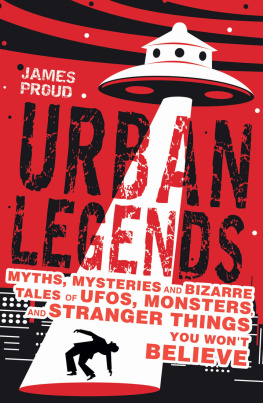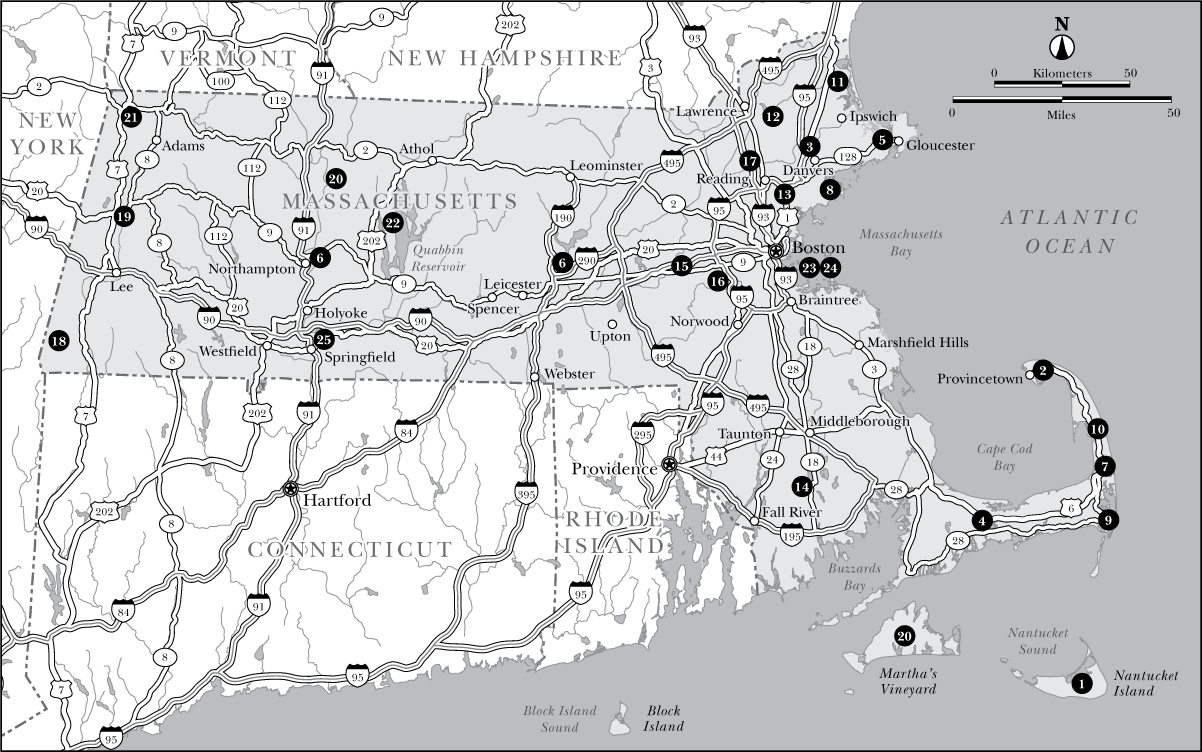spooky trails and tall tales MASSACHUSETTS

An imprint of Globe Pequot, the trade division of
The Rowman & Littlefield Publishing Group, Inc.
4501 Forbes Blvd., Ste. 200
Lanham, MD 20706
www.Falcon.com
Falcon and FalconGuides are registered trademarks and Make Adventure Your Story is a trademark of The Rowman & Littlefield Publishing Group, Inc.
Distributed by NATIONAL BOOK NETWORK
Copyright Stephen Gencarella
Map by The Rowman & Littlefield Publishing Group, Inc.
All rights reserved. No part of this book may be reproduced in any form or by any electronic or mechanical means, including information storage and retrieval systems, without written permission from the publisher, except by a reviewer who may quote passages in a review.
British Library Cataloguing in Publication Information available
Library of Congress Cataloging-in-Publication Data
Names: Gencarella, Stephen Olbrys, 1971 author.
Title: Spooky trails and tall tales Massachusetts : hiking the states legends, hauntings, and history / Stephen Gencarella.
Description: Guilford, Connecticut : Falcon, 2021. | Includes bibliographical references and index. Identifiers: LCCN 2021017013 (print) | LCCN 2021017014 (ebook) | ISBN 9781493060429 (paperback) | ISBN 9781493060436 (epub)
Subjects: LCSH: HikingMassachusettsGuidebooks. | TrailsMassachusettsGuidebooks. | Ghost stories, AmericanNew England. | MassachusettsHistory.
Classification: LCC GV199.42.M4 G46 2021 (print) | LCC GV199.42.M4 (ebook) | DDC 796.5109744dc23
LC record available at https://lccn.loc.gov/2021017013
LC ebook record available at https://lccn.loc.gov/2021017014
 The paper used in this publication meets the minimum requirements of American National Standard for Information SciencesPermanence of Paper for Printed Library Materials, ANSI/ NISO Z39.48-1992.
The paper used in this publication meets the minimum requirements of American National Standard for Information SciencesPermanence of Paper for Printed Library Materials, ANSI/ NISO Z39.48-1992.
The author and The Rowman & Littlefield Publishing Group, Inc. assume no liability for accidents happening to, or injuries sustained by, readers who engage in the activities described in this book.
For Charlie Johnson.
And to the memory of Clifton Johnson.
Contents
Guide
Massachusetts has been very kind to me. I met the love of my life there and together we welcomed all four of our children to the world. And I have buried beloved dogs in its soil.
As a teenager growing up in Rhode Island I would borrow my grandfathers station wagon, drive to Alewife with friends, and wander throughout Boston. (He took the blame for the mileage when my grandmother asked too many questions.) I hold fond memories of Fenway and Foxboro Stadium and of sites stretching from the Berkshires to the Cape. In my early twenties, I had the pleasure of teaching Latin at Norwood High School. And for the past two decades I have been gainfully employed as a professor at the University of Massachusetts, Amherst. These and other opportunities allowed me to live in towns as diverse as Salem, Uxbridge, Charlemont, and Montague. I will forever be grateful to the Commonwealth and its people.
I am thankful, above all, to my favorite hiking companions: my wife, Winnie, and our children, Salvatore, Angeline, Antonio, and Marcella.
Although fatein the form of a pandemichas kept us from hiking together, I have traveled a long way with my editor, Dave Legere, and all to my benefit. I am profoundly grateful for his guidance, patience, and good humor.
I will thank my friend and fellow critical folklorist Ray Huling as often as I am able. Rays advice is never incorrect, and this book was made better by it.
I have the good fortune to call Chris Dobbs, Erik Ofgang, and Anthony Bak Buccitelli friends. Their leadership, scholarship, and impeccable writing are a constant source of inspiration.
A book of this sort is only possible with the support of friends and colleagues. I would like to thank all of them for their encouragement and contributions to our world: Katie Abbondanza, Pam Adams, Robin Andreoli, Meir Yishai Barth, Nick Bellantoni, Lauren Bergnes, Lisa Bernardi, Dotty Snow Bicknell, Bingk (Sharon Houle), Dan Bolognani, Daniel Bosques, Tanya Bourgoin, Rachel Briggs, Rosa Briggs, Marge Bruchac, Lois Bruinooge, Ryan Conary, Tary Coppola, John Coston, Joe Cote, Chloe Deeley, Heather and John DiPaolo, Ed Dombroskas, Eliza Donhauser, Greg Dorchak, Shara and Neal Drew, Davis Dunavin, Eddie Guimont, Alannah Finlay, Steph and Alex Foulkes, Jill Fritzsche, Chris Gilbert, Katie Gohde, Sal Gencarelli, Wick Griswold, Pete Haase, Evan Helmlinger, Sharon Hill, Scott Jauck, Karl Johnson, Fran Kefalas, Donna and Neal Kirk, Ann and Felix Kloman, hari stephen kumar, Allie Kyff, Debra and John Lawless, Caleb Lincoln, Tony Lupinacci, Ange Lussier, LRB (Linda Reilly-Blue), Michael Lee-Murphy, Mary Mazur, Troy Medinis, Russ Miller, Atticus Nischan, Daniel Nischan, Brenda and Bob Osborn, Glenn Ostlund, Tyra Penn-Gesek, Deryn Pomeroy, Maureen Quintin, Mark Rampmeyer, Cor-delia and Andy Roth, Carl Ruck, Juliet Rutigliano, Rachel Sayet, Rita Schmidt, Kate Schramm, Bird Stasz, Becky Townsend, Molly Turner, Porntip Twishime, Greg Wharmby, Jen White-Dobbs, Anya Wilczynski, Dave Williams, Gary Williams, Rachel Wood, Dave Worthington (and old blue), and Dottie Zellman. Im grateful to senior production editor Jehanne Schweitzer, typesetter Joanna Beyer, and proofreader Paulette Baker for their work seeing the book through production.
Twenty years ago, I wrote a dissertation that concluded with my imagining the composition of a guidebook that would promote responsible tourism. In many ways, this present volume is an attempt at that devilish plan. And the gratitude to my mentors John Louis Lucaites, Dick Bauman, Bob Ivie, and John McDowell is inexhaustible.
I would like to thank the staff, volunteers, and board members of all National Heritage Areas and Corridors in Massachusetts: Blackstone River Valley, Essex, Freedoms Way, Last Green Valley, and Upper Housa-tonic Valley. I would also like to salute the exemplary work of all of my colleagues in FINE (Folklorists in New England).
I am, as always, grateful to my colleagues in the Communication Department at the University of Massachusetts, Amherst. And I cannot tire of expressing the great honor it is to have worked with all the studentsthousands nowand the privilege it will be to work with all those in the decades ahead.
One of the pure joys of writing this book was the excuse to read the work of masterful storytellers who themselves clearly admire Massachusetts and its folklore. Please take my advice. Your life will be better if you read every word written by Clay Perry, Elizabeth Reynard, Marilynne Roach, and Edward Rowe Snow. Likewise, the dedication to the study of Massachusetts folklore by George Carey and William Simmons should never be forgotten. And the scholarship and activism of Gladys Tantaquidgeon will forever remain a model to inspire us all.
The older I amI turn a half century this yearthe happier I become that I chose my intellectual heroes wisely. And every day that I wrote another line of this book, I hoped that it would echo in some way what I have learned from Clifton Johnson. Although Johnson (18651940) has long been praised in small circles, he has never received the accolades he deserves as a monumental figure for the folklore of New England. Discovering his work was a watershed moment in my career. It convinced me that the life of a cloistered academic would be a useless endeavor and that the best folklorists write to be read by the public. I regard this book as a letter of respect and indebtedness to all his contributions.






 The paper used in this publication meets the minimum requirements of American National Standard for Information SciencesPermanence of Paper for Printed Library Materials, ANSI/ NISO Z39.48-1992.
The paper used in this publication meets the minimum requirements of American National Standard for Information SciencesPermanence of Paper for Printed Library Materials, ANSI/ NISO Z39.48-1992.